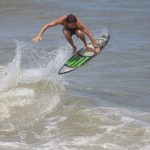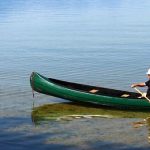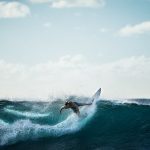I’m sure you’ve at least heard of skimboards before, even if you don’t know exactly what they are. Unlike stand-up paddleboards, skimboards are only meant to catch waves and quickly move over shallow water, so they’re a lot smaller.
Paddle boarding is about stability and being able to stay on the board, while skimboarding is about catching waves and being okay with falling into the water. With skimboarding, you have more adventure and adrenaline, so it doesn’t matter if you get wet.
A skimboard is a small board, usually between 110 and 150 cm long, made of wood or foam. This type of board allows the rider to move quickly with the waves, but provides less balance.
Foam skimboards are a better choice for beginners because they are larger and more buoyant. Wooden skimboards are more suitable for advanced skimboarders because they can achieve high speeds on shallower surfaces with less friction.
What is Skimboarding?
Skimboarding is a bit like surfing, but you don’t need waves to get started. You drop your board on the water and use your momentum to skim out to the waves. Once you’re there, you can catch the waves and ride them back to shore.
Skimboarding is all about surface and air maneuvers, like “wraps”, “big spins”, and “360 shove-its”.
Skimboarding also involves doing tricks that are similar to skateboarding, such as ollies and shove-its, on the surface of the water without catching a wave. Skimboarding began in Southern California when the lifeguards at Laguna Beach wanted to surf the shore breaks, which were too fast and shallow for surfboards.
Skimboarding has changed since then so that people ride waves similarly to how they surf, doing aerial maneuvers and going into the barrel of the wave. Some professionals even ride behind a wave runner in order to catch much larger waves.
Skimboard Characteristics
A rider’s favorite board length is typically around their mid-chest height when standing on end.
The thickness of the typical board ranges from 1 to 2.5 cm (3⁄8 to 1 in). The most common thicknesses are 1.5 to 2 cm (5⁄8 to 3⁄4 in). A few boards have been built with thicknesses over 5 cm (2 in). A 1.5 cm (5⁄8 in) board is capable of sharper turns while sacrificing a little speed. A 2 cm (3⁄4 in) board will be able to glide out farther, but turns slightly slower.
The three types of rockers generally used for skimboards are a constant rocker, a hybrid rocker, and a traditional rocker. Constant rockers are known for better control on bigger waves and steeper slopes. Hybrid rockers have a curve on the bottom through about three-quarters of the board’s length, the rest (meaning the flat part) is usually the tail.
This type of rocker is good for both speed and control on decent size waves; also the best type of board for flatland tricks. Traditional rockers are almost completely flat except for the nose. A traditional rocker is typically used for east coast conditions where the waves are far out.
Dangers
There are many types of dangers that skimboarders can face daily. It is not uncommon to see fractures or dislocations of the lower limbs, some requiring serious medical attention. Lacerations, twisted ankles, and bruises are also common, due to impacts with the board itself, or rocks, logs, and other obstacles present on beaches.
Hamstring injury is also common due to the fast and extreme movement of a skimboarder’s legs when they run toward the water and jump on the board. Drowning amongst skimboarders is not as likely as amongst surfers due to the shallow water in which skimboarding is usually practiced.
Even though there are things that might cause these injuries, it mostly relies on the conditions of the waters. Places with calm waters and small waves have little to no injury cases.Skimboard injuries are most common at California beaches, accounting for 85% of all injuries.
However, these injuries can be avoided if the rider makes smart choices and only skimboards in safe conditions.
Locations
The center of the skimboarding world is largely considered to be Laguna Beach, California. It was here in the late 1920s that skimboarding first became popular among lifeguards. Every summer, the Victoria Skimboards company sponsors a large skimboarding competition called the VIC, which is held at Aliso Beach in Laguna.
Other popular Laguna skimboarding locations include Tenth Street, West Street, Treasure Island, Thalia Street, and Crescent Bay. On the East Coast, the best skimboarding spots are generally agreed to be Vilano Beach and Vero Beach, Florida; every year in August, they play host to the Florida Pro/Am, the biggest East Coast skimboarding competition.
Other notable skimboarding beaches on Florida’s west coast include Sarasota, Clearwater, and Anna Maria Island.However, people skim in many other locations throughout North America, Europe (the main locations being Portugal, France, Spain, the United Kingdom, and the Netherlands), Australia, Asia, the Middle East, and South America.
Some people skim inland because of difficulty with shore access. Flatland skimboarding can be done nearly anywhere: lakes, rivers, creeks, ponds, golf courses, puddles, or even wet grass. In the United States, flatland skim scenes have developed primarily in states that are not bordering the ocean. Flatland has also developed in British Columbia, Ontario, and along the Great Lakes.
Skimboarding is a popular activity in many places around the world, including Australia, New Zealand, and Europe. The sport is especially popular on beaches where surfing is not possible, such as Boa Viagem in Brazil.
Isreal is a great place to skimboard because of its steep slopes and heavy beach break.
How Does a Skimboard Work?
A skimboard is a small, thin board that you can use to slide over the waves.
If you have enough practice, you can propel your board across the water and ride the waves for a certain amount of time, similar to what surfers do. Also, if you have enough speed, you can even do tricks such as jumps, as shown in the photo.
However, this isn’t possible for people who are just starting out.
The short physics lesson is as follows: when you ride a skimboard, you are effectively riding on a thin layer of water that is held up by the waves. This is because the waves push the water up as they come towards the shore, and the water then pushes back against the waves.
This back-and-forth action makes the waves move forward, and it also makes the water level rise. When you ride a skimboard, you are effectively riding on a thin layer of water that is held up by the waves.
The waves push the water up as they come towards the shore, and the water then pushes back against the waves. This back-and-forth action makes the waves move forward, and it also makes the water level rise.
Displacement of Water
A skimboard is a small craft that is similar to a boat but uses human power instead of an engine. However, both have one thing in common: when they move, they move water. The more water they move, the slower they move.
Skimboarding tries to use as little energy as possible so that people can move across the water for a longer period of time.
The more water a skimboard has to move out of the way, the more energy is required from the user, which results in a slower ride. Skimboards work better in shallow water because there is less water for them to move.
The Ground Effect
The ground effect allows a skimboard to glide across the water. The board is able to push the water down due to its close proximity to the bottom of the water. The ground then pushes the water up again, creating small masses of swirling water.
This allows the board to glide across the water with ease.
In other words, you can make the skimboard move forward by pushing it down into the water and then releasing it. The pressure that is exerted on the water between the board and the bottom of the body of water will cause the board to move.
The swirling of the water around the board prevents it from touching the bottom, which allows the board to skim along the surface until it reaches deeper waters. This is similar to how a helicopter floats for a moment after taking off and almost touches the ground.
The rotating blades on a helicopter push air downwards, creating a vortex. The vortex creates lift, which allows the helicopter to take off. You can see the effect of the vortex when the helicopter is close to the ground, as the blades blow up dirt and dust particles.
Does “Pumping” Work on Skimboarding?
A common term among skimboarders for moving their legs in deeper water to stay afloat is “pumping.”
Skimboards have a smaller surface area than surfboards. Therefore, they don’t float on water for as long as surfboards do. Consequently, skimboarders have to pump their boards when they reach the point where the waves stop.
To pump a skimboard, the rider moves their front foot up and down on the nose of the board. This action keeps the board afloat for a longer period of time and allows the rider to travel further across the water at a faster speed.
The surprisingly slowing movement of a skimboarder is created by a pumping motion that rocks the board back and forth on the water surface.
The repeated movement causes the board to sink and then spring back out of the water.
Now that you’ve learned how a skimboard works, we’ll continue with an introduction to the boards themselves and which boards you should choose to start skimboarding yourself.
How Do I Choose the Right Skimboard?
Picking the right skimboard can be tough. The good news is that a size chart and a few scientific rules will solve the most common doubts.
It is important to take note of your height and weight when choosing a skimboard, just as you would when choosing a SUP board.
First, consider whether you are a beginner or experienced skimboarder. If you are a beginner, you may want to find a board that is easy to use. If you are an experienced skimboarder, you may want to find a board that is more challenging. Second, think about how often you want to go skimboarding.
If you want to go skimboarding more often, you may want to live near the water. If you only want to go skimboarding on holiday or once in a while, you may not need to live near the water. This will help you decide what the board you are looking for should meet.
Most manufacturers make foam skimboards with a fiberglass or resin exterior. Carbon and wooden boards are more expensive and used more often by professionals.
Foam models are less dense then water and will float while wooden boards are denser then water and will sink. Skimboarders who want to tackle waves use foam models because they are more buoyant.
Skimmers who stay closer to shore use wooden boards because they are heavier and can move quickly over shallow water.




